Chronic Inflammation May Enhance Leiomyoma Development by the Involvement of Progenitor Cells
- PMID: 29861738
- PMCID: PMC5971255
- DOI: 10.1155/2018/1716246
Chronic Inflammation May Enhance Leiomyoma Development by the Involvement of Progenitor Cells
Abstract
Although the etiology of leiomyoma is unclear, a progenitor/undifferentiated cell population has been described whose dysregulation may be involved in the onset of uterine conditions. Moreover, inflammation is involved in the development of several tumors. The aim of this work was to understand if progenitor cells sustain a chronic inflammatory microenvironment that enhances leiomyoma development. Cells from 12 human leiomyoma and 12 normal myometrium samples of the same patients were in vitro isolated and exhaustively characterized (morphology, proliferation, cytofluorometry, differentiation, RT-PCR, immunofluorescence, immunohistochemistry, and Western blotting assays). Selected cytokines (ELISA) and inflammation-related genes (RT-PCR) were analyzed to identify healthy myometrium progenitor cells (MPCs) and leiomyoma progenitor cells (LPCs). Results show that (i) MPCs and LPCs share stemness features, such as immunophenotype and multidifferentiation assay, (ii) LPCs have a significantly shorter doubling time and a significantly higher expression of stemness genes (p < 0.05), and (iii) LPCs secreted significantly higher levels (p < 0.05) of cytokines related to chronic inflammation and significantly lower amounts (p < 0.05) of cytokines related to acute inflammation. Despite the limited sample size, comparisons between leiomyoma and normal myometrium tissue from each patient allowed normalization of patient-specific differences. The evidenced cytokine expression pattern related to chronic inflammation in LPCs may play a role in the increased risk of adverse obstetric outcomes (infertility, spontaneous miscarriage, and preterm birth) in women affected by leiomyomas. These women should be recognized as "high risk" and subjected to specialized management both before and during pregnancy.
Figures
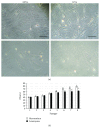
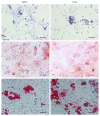
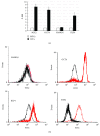
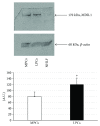
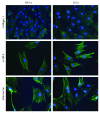
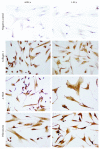

Similar articles
-
Differentially regulated expression of neurokinin B (NKB)/NK3 receptor system in uterine leiomyomata.Hum Reprod. 2013 Jul;28(7):1799-808. doi: 10.1093/humrep/det128. Epub 2013 May 8. Hum Reprod. 2013. PMID: 23656837
-
Differential effects of tumor necrosis factor-α on matrix metalloproteinase-2 expression in human myometrial and uterine leiomyoma smooth muscle cells.Hum Reprod. 2015 Jan;30(1):61-70. doi: 10.1093/humrep/deu300. Epub 2014 Nov 14. Hum Reprod. 2015. PMID: 25398968
-
Aberrant expression of erythropoietin in uterine leiomyoma: implications in tumor growth.Am J Obstet Gynecol. 2015 Aug;213(2):199.e1-8. doi: 10.1016/j.ajog.2015.02.016. Epub 2015 Feb 25. Am J Obstet Gynecol. 2015. PMID: 25724399
-
Tissue-specific stem cells in the myometrium and tumor-initiating cells in leiomyoma.Biol Reprod. 2014 Dec;91(6):149. doi: 10.1095/biolreprod.114.123794. Epub 2014 Nov 5. Biol Reprod. 2014. PMID: 25376230 Free PMC article. Review.
-
Epidemiological and genetic clues for molecular mechanisms involved in uterine leiomyoma development and growth.Hum Reprod Update. 2015 Sep-Oct;21(5):593-615. doi: 10.1093/humupd/dmv030. Epub 2015 Jul 3. Hum Reprod Update. 2015. PMID: 26141720 Free PMC article. Review.
Cited by
-
Endocrine-Disrupting Chemicals and Vitamin D Deficiency in the Pathogenesis of Uterine Fibroids.J Adv Pharm Res. 2021 Spring;5(2):260-275. doi: 10.21608/aprh.2021.66748.1124. J Adv Pharm Res. 2021. PMID: 34746367 Free PMC article.
-
miRNAs, Mesenchymal Stromal Cells and Major Neoplastic and Inflammatory Skin Diseases: A Page Being Written: A Systematic Review.Int J Mol Sci. 2023 May 9;24(10):8502. doi: 10.3390/ijms24108502. Int J Mol Sci. 2023. PMID: 37239847 Free PMC article.
-
BCL-6 Overexpression as a Predictor for Endometriosis in Patients Undergoing In Vitro Fertilization.JSLS. 2020 Oct-Dec;24(4):e2020.00064. doi: 10.4293/JSLS.2020.00064. JSLS. 2020. PMID: 33414614 Free PMC article.
-
Uterine Stem Cells and Benign Gynecological Disorders: Role in Pathobiology and Therapeutic Implications.Stem Cell Rev Rep. 2021 Jun;17(3):803-820. doi: 10.1007/s12015-020-10075-w. Epub 2020 Nov 5. Stem Cell Rev Rep. 2021. PMID: 33155150 Free PMC article. Review.
-
Role of inflammation in benign gynecologic disorders: from pathogenesis to novel therapies†.Biol Reprod. 2021 Jul 2;105(1):7-31. doi: 10.1093/biolre/ioab054. Biol Reprod. 2021. PMID: 33739368 Free PMC article. Review.
References
LinkOut - more resources
Full Text Sources
Other Literature Sources

